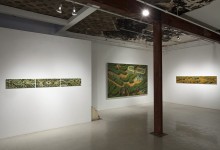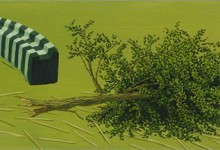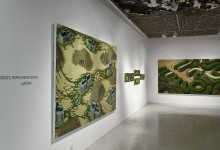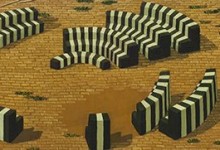Text by Jaynus O’Donnell
Judith Berry’s playful, yet ominous landscape paintings conjure immediate visual associations. Suggestions of aerial mapping, children’s building block toys, candy, mazes and mythical worlds are present in the works. In viewing these paintings I instantly find entry points that are simultaneously nostalgic and pastoral, maintaining enough ambiguity to allow narrative interpretations to wander and remain dynamic.
The works imply concurrent processes of construction and destruction. The architectural elements consisting of natural materials (wood, sticks, grass) and human-made forms (black and white plastic-like structures, brick, pruned bushes) appear to be in the midst of completion. While the destructive aspects, such as fallen trees; collapse; temporary structures and erosion, appear to foster the progress of construction through provisions of material and space. The viewer is initially invited directly into the work as a builder and there is ample room in the works for their imaginings to become additions to the landscapes and to the activities therein.
The cyclical implications of these courses of erection and collapse combined with a constant sense of rebuilding imply a passage of time and human (or possibly animal) activity. However, these temporal and circumstantial impressions remain only as intuitions. The uncertainties embedded in the works seem to be the result of a scarcity of contextual information about the time and space of the landscapes. Scale is greatly ambiguous without such reference points as human figures. It seems just as plausible, within the same landscape, for a giant hand to sweep in and rearrange a pile of sticks as it does for a tiny person to require assistance from machines or other people in completing the same task. There is also little information about the structures’ uses, how long they have been there for, who made them and from what materials.
These questions and the minimal contextual information does not arise from a lack of clarity in the work, rather, it seems that these inquiries are formed by using recognizable imagery with odd variations in tandem with confusing scale and spatial considerations. Black and white structures, reminiscent of licorice candies, act as buildings with seemingly no entrance and hedges form mazes that appear to never trap you in a dead-end. The paintings urge the viewer to enter the world and attempt to answer the questions that emerge during viewing and thus, further implicate the audience personally into the work.















